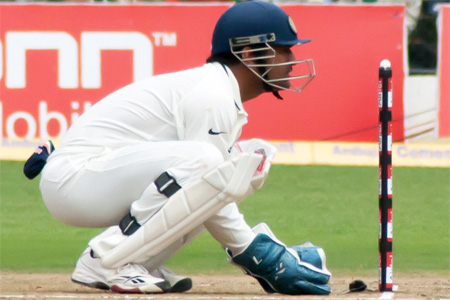|
|

|
|

Fielders assist the bowlers to prevent batsmen from scoring too many runs. There are several types of field positions and the captain of the fielding team decides different combinations of them for tactical reasons. Since there are 11 players on a team, one of whom is the bowler and another the wicket-keeper, at most nine other fielding positions can be used at any given time. The captain may move players between fielding positions at any time except when a bowler is in the act of bowling to a batsman.

The wicketkeeper who stands behind the batsman on strike at the wicket, sets the tone for the fielding side. His role is to stop balls that pass the batsman and attempt to dismiss the batsman in various ways.
Most important fielding position in the game. The fielder at First slip, normally stands closest to the wicketkeeper.
The fielder at Second slip stands just to the offside of first slip. The second slip is likely to be used in the first couple of over's of a match or if a team is employing an attacking field in an attempt to finish an innings off.
The Gully fielder covers the area just square of the wicket on the off side but the fielder will tend to vary where they stand according to the pitch and the batsman. Gully is employed in catching the ball after it hits the edge of the bat and deflects a long way, or for misplaced cut shots.
This is a boundary position right behind square on the offside. The fielder at Third man has to covers a large area, preventing anything that pierces the slip and gully area.
A position on the off side and located at 90 degrees to the batsman. The Point fielder's job is to catch the ball from a misplaced cut shot, or to prevent runs from cut shots, square drives, and defensive strokes square on the off side.
This is the fielding position on the off side in front of the wicket.
Deep point is a defensive position on the off side and the fielder at this position is usually stationed on the boundary.
This is fielding position in front of the wicket and the position designed to prevent runs from cover drives, defensive strokes on the off side.
This is the fielding position in front of the wicket. A strong off side field would probably have both a cover and an extra cover.
This is the fielding position in the deep outfield near the boundary used when the fielding side wants to keep the runs to the bare minimum.
This is the fielding position on the off side, and the position is almost mid way to the wicket and very close to the batsman.
This is the fielding position on the off side, and the position is almost straight in line with the bat to prevent runs from off drives, and defensive strokes on the off side.
A fielding position on the off side and has to cover a large area from the sight screen to the sweeper cover position and near the boundary to prevent runs from off drives or catch long, lofted off drives.
A fielding position on the leg side of the wicket to prevent runs from on drives or catch long, lofted on drives.
A fielding position on the leg side almost straight of the batsman to prevent runs from on drives, and defensive strokes on the on side
This is positioned on the leg side and the position is designed generally to either catch the ball from a misplaced pull shot, or to prevent runs from on drives, and defensive strokes on the on side.
This is positioned on the leg side near the boundary to prevent boundaries.
This is positioned on the leg side forward of the strikers wicket and very close to the batsmen generally use to put pressure on them.
A fielding position to the right of forward square leg and very close to the batsman. This position usually given to the youngest member of the fielding side and employed against players who are especially strong off their hips.
This position is similar to first slip on the leg side and is very often referred to as leg slip.
This position is on the leg side. This is also the position for the leg umpire. Between the wicket and the square boundary, it prevents the batsman from going for pull shots.
This position can also be monitored by the fielders from the deep mid wicket and deep fine leg regions.
This is the fielding position on the leg side to the right of the square leg region designed to catch the ball from a misplaced bock or other defensive shot.
|
|